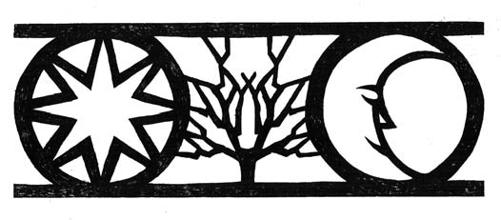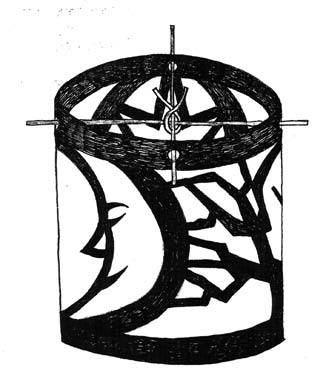Read The Old Magic of Christmas: Yuletide Traditions for the Darkest Days of the Year Online
Authors: Linda Raedisch
Tags: #Non-Fiction
The Old Magic of Christmas: Yuletide Traditions for the Darkest Days of the Year (9 page)
was able to stare straight ahead when offered silver chal-
ices and gold book mounts but could not help gazing long-
ingly at a spoonful of hot meat drippings. If you can hold out without speaking or glancing from side to side, then
you can praise God aloud at first light and the elves will be forced to leave the proffered gifts behind, but no one has ever accomplished this. In fact, the sitter is often the worse for the encounter: that’s how it goes when you expect to get something for nothing.
If you’re not looking for treasure, and you don’t par-
ticularly want to know what the future holds, you can still celebrate New Year’s Eve with the elves. There were no
household sprites on the Icelandic sheep farm—the lit-
tle fellows never made it that far—but in the Middle Ages, a few devoted women set out food offerings at a distance
from the house on New Year’s Eve. They also placed extra
lights about the grounds to invite the weary elves to come inside and rest their feet before traveling on to their new homestead. Back in Norway, Sitting Out took place as
needed, not necessarily during the long nights of Yule, but the Icelanders’ concept of an elves’ moving day is specific to the Christmas season.
64 Dead by Christmas Morning
Though they’re usually a little bit behind the times, our
otherworldly brethren are not incapable of change. Moving
elves might now appear as a normal-looking family with a
U-Haul in tow. I would not advise inviting any unknown
singletons inside your home on Christmas, New Year’s or
any other Eve, but if a bedraggled, slightly retro-looking clan including women and children shows up and asks for
help changing a tire, don’t shut the door in their faces. Once you have done them a service, you can accept any gift they offer. Whatever it is, don’t throw it away; it may turn into something more valuable in the morning.
Oh, and if you’re still wondering what the gray cat was
for, you’re going to have to summon the ghost of Icelan-
dic folklorist Jon Arnason who collected these instructions in the nineteenth century but never followed up on the cat.
Craft: Elf Wreath
Some of your elvish guests may depart as soon as you’ve
cleared your Álfablot table. Others might decide to stay for the whole festive season. Put this wreath up early and dedicate it to the elves alone. For a base, you can use grapevines or a bare ring of plastic or wood. Wrap the ring all around with a string of clear or colored lights, then wind a long strip of gauze, cheesecloth or veiling loosely over the lights to create a softer glow. You can remove the cloth on Christmas Eve at the height of the festivities. Taking the wreath down at Twelfth Night (January 6) will be a hint to any lingering otherwordly guests that it’s time to be moving along.
Bid them a fond farewell and invite them to come back next year.
Riders on White Horses
By early November, winter is already spreading its dark
cloak over the landscape. What better time to send the
children parading through the streets with pretty lights? In Germany’s Protestant north, this can happen any time during the autumn. In the Catholic south, lantern processions are centered around the larger observance of St. Martin’s
Day on November 11. There, the Christmas season is ush-
ered in by the figure of St. Martin himself, riding into town on a white horse, his costume put together by the alder-men’s wives in approximation of a Roman soldier, complete
with helmet, horsehair crest and scarlet cape. According to his legend, St. Martin surrendered half his cloak to a shivering beggar who turned out to be Jesus himself.
In the German saying, “St. Martin comes riding on a
white horse,” the horse is the embodiment of the first snow-fall. While the figure of the saint disappeared from pageants in the north, the horse did not. The
Schimmel
or “white horse,” consisted of one to four men under a white sheet,
65
66 Riders on White Horses
holding a hollow, carved head on a pole. A pot of live coals might be placed inside the head, making the mouth and
eyes glow red. When the Schimmel had a rider, the whole
thing was called a
Schimmelreiter
and thus became a kind of hobby horse.
Sun, Moon and Stars
Protestant or Catholic, Martinmas lanterns are supposed to represent the light of the Christian faith, but the tiny flames are also late expressions of the bonfires that once marked winter-nights, the ancient pagan New Year at the end of
October. In the old days, if you wanted to send a small child out after dark to sing and beg for sweets, you had to provide him or her with a reliable, not readily flammable or
breakable light source. Such a lantern could be made from
a turnip or a
Kürbis
, a smaller, ruddier version of the American pumpkin. The lanterns were carved with frightening
faces, for who knew what other creatures might be about
in the frosty autumn night? Better for the children to carry their own goblins’ faces, so that when the light shone out of them it would send the real goblins scuttling back into the hedgerows. And just to be on the safe side, the children themselves might dress as ghosts or other unearthly spirits.
Among farm children, both Protestant and Catholic,
these customs survived into the twentieth century while
in the cities, children starting carrying Chinese paper lanterns. Today, you can buy a paper lantern ready-made for
the occasion, the face decorated with the sun, moon or
stars celebrated in the old, slightly mournful folk songs that accompany the processions. School children often make

Riders on White Horses 67
their own paper lanterns out of papier-mâche or black
paper and cellophane. When the odd flare-up occurs, the
lantern is simply dropped and stamped out on the cobbles.
Craft: Martinmas Lantern
The following craft features
Scherenschnitte
, a German folk art in which figures, plants, animals and fairytale scenes are cut from a single sheet of paper. Scherenschnitte artists work in both black and white paper—Hans Chris-
tian Andersen was famous for his spontaneous cuttings
in white—but for this project black provides the most
dramatic effect. If you use the template in this book, you should first enlarge it at least fifty percent.
Martinmas Figure 1
Tools and materials:
1 sheet black paper, 9 x 12 or larger (Poster board is too think but construction paper will do.)
Tracing paper
Bristol board or thin cardboard
Clear tape
Glue
Scissors
68 Riders on White Horses
X-Acto or other craft knife
Hole punch
Tea light
2 shish kebab skewers
Loop of thin wire
Long stick or dowel for carrying lantern
Lay the template sketch on the black paper, tape securely in place at the edges and cut out all the white spaces with your knife. Take your time, but if you do slip up, you can make repairs with tape or glue when you mount the piece on the
tracing paper.
When your picture is all cut out, coat the back with glue
and mount it on the tracing paper. Smooth the piece gently with your hands to make sure all the fine details are stuck firmly to the tracing paper.
When the glue is dry, bend your work of art into a cyl-
inder—tracing paper on the inside—and carefully close the
seam with a strip of clear strong tape. It will look best if the tape is on the inside of the cylinder.
To make the right size base, trace the bottom of the cyl-
inder on a piece of Bristol board. Cut out the circle, leaving a ½ inch margin all around. Cut slits all around to make tabs.
Fold the tabs up, dab each tab with glue, and slide the base into the bottom of the lantern cylinder.
Glue or tape a tea light into the lantern base. When the
first candle has burnt out, you can drop a new one into
the same holder. But before you strike the match, punch
four equidistant holes in the upper border of your lantern.
These are for the shish kebab skewers to pass through.


Riders on White Horses 69
Martinmas Figure 2
Now light the candle. If your lantern is tall, you will
probably want to use a fireplace match. Slide the skewers
through the holes and through the wire loop, being care-
ful not to burn yourself as the heat rises up from the candle flame. Hook your carrying stick through the loop and
you’re ready to set off into the dark streets.
Martinmas Figure 3
70 Riders on White Horses
Martinmas Treats
Although there is no mention of wolves in the legend of St.
Martin, the Martinmas snows once brought out wolves in
the form of the
Pelzmarten
, men dressed up in shaggy furs.
Rather than eat the children, they threw apples to the good ones and beat the bad ones with a whip or rod. The tradition dates back to the fifteenth century at least and may be even older than the “Furry Nicks” we’ll meet on St. Nicholas’ Eve.
There is no mention of horns in St. Martin’s legend
either, but they, too, have become a part of his day. Pastries known as
Martinshoernchen
or “little Martinmas horns”
may represent the hunting horn which once belonged to
the god Woden. Then again, the crescent shape might rep-
resent the moon which can be seen bobbing in the alleys
along with the sun and stars at this time of year. In bygone days, St. Martin himself was believed to enter the house on the eve of his feast day. Once inside, he turned the jug of water left out for him into wine, depositing a little horn-shaped pastry beside it when he left.
Recipe: Martinmas Horns
There is no one definitive recipe for
Martinshoernchen
.
Some call for a yeast dough, others, like this one, for a short pastry dough. To this day, Martinshoernchen, which are not overly sweet, are eaten as breakfast buns in the fall.
Ingredients for the dough:
2 sticks (one cup) unsalted butter, softened
¾ cup sour cream
1 egg yolk
Riders on White Horses 71
2 Tablespoons sugar
2 ½ cups flour
For the filling:
1 small jar (8 oz) apricot jam
About 3½ oz marzipan, i.e. half a box Odense or other
brand “almond candy dough”
Pinch cinnamon
For the glaze:
1 egg white
In a large bowl, mix all of the dough ingredients, adding the flour a little at a time. When the flour has all been worked in, form the dough into a ball. It will be sticky. Wrap the ball lightly in plastic wrap and refrigerate several hours or overnight.
Cut the chilled dough into four quarters. Work with one